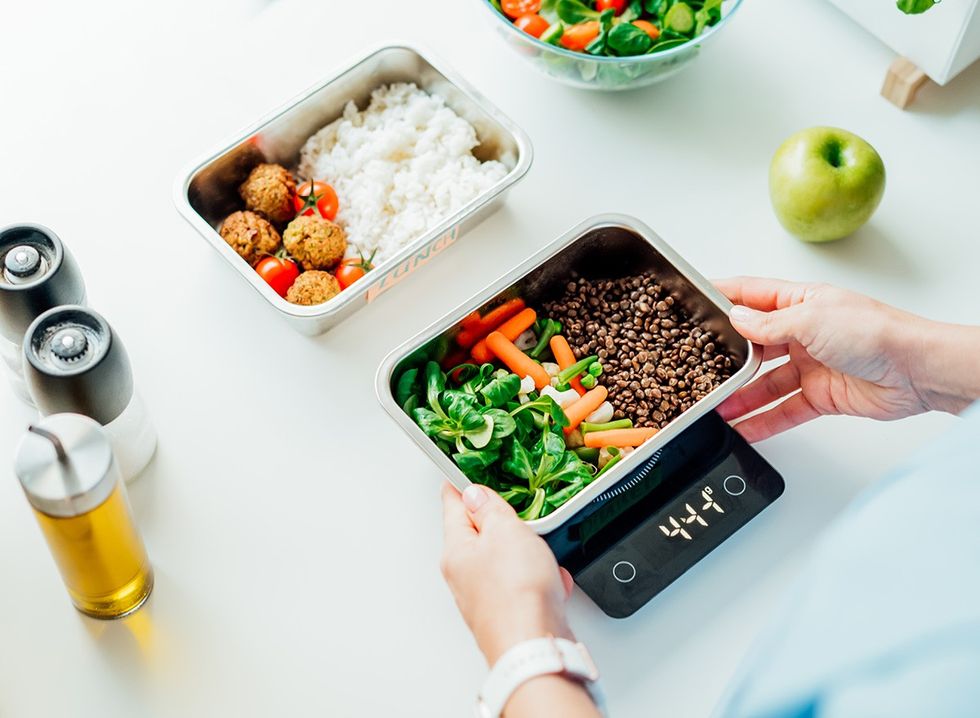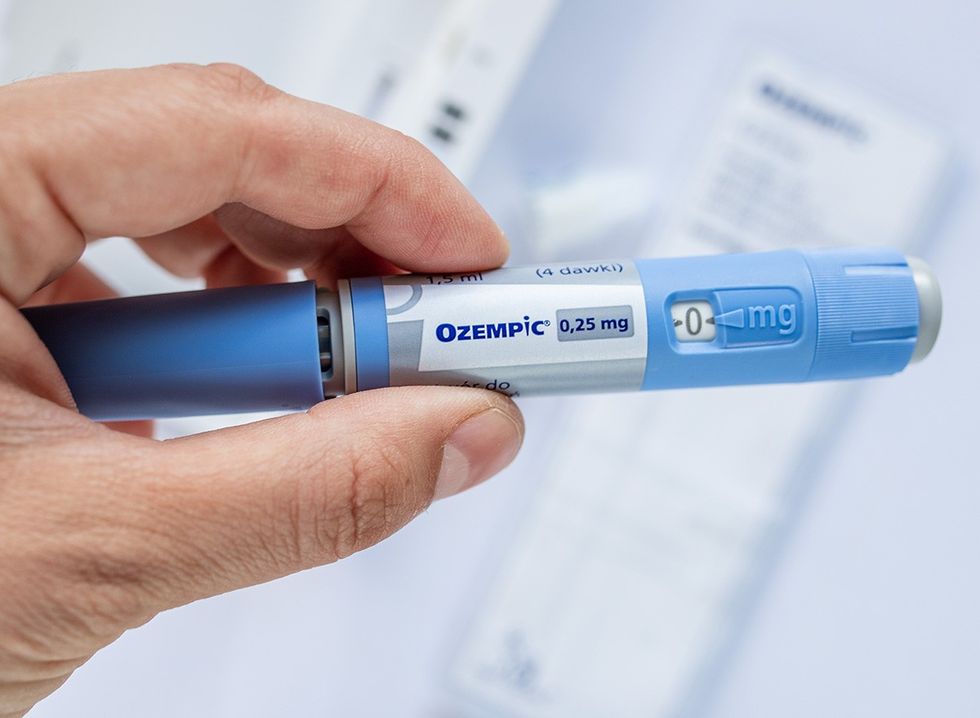We've all been there – caught without a healthy snack when hunger strikes, leading to less-than-ideal food choices or overeating later. Michelle Roots, a kinesiologist, personal trainer, and nutrition coach with over 16 years of experience, understands this struggle. In her recent video, she shares her top eight high-protein, healthy snacks for people on the go, emphasizing the importance of preparation: "Failing to plan is planning to fail. It does not take a lot of work to have these options in your car, in your bag, and at your desk at work versus having to go to the vending machine or the fast food."
Keep reading to discover protein-packed snacks that can help you lose stubborn fat, boost your overall health, and fuel your success.
Why Carry Healthy Snacks?

Michelle emphasizes in her video the importance of having healthy snacks readily available. "Do you ever find yourself at work or just out of the house without any snacks in your bag or in your car, which forces you to either not eat at all and starve yourself or stop for fast food?" she asks in her video. By preparing these snacks in advance, you can avoid unhealthy eating habits and maintain your nutrition goals.
Cheese: A Portable Protein Source

The first recommendation in her video is baby bell cheese or cheese strings. Michelle points out, "This is probably about six to eight grams of protein in this one cheese for less than a hundred calories." She suggests carrying two baby bell cheeses for a quick 10-gram protein boost with only 120 calories.
Protein Bars: Convenient and Tasty

Protein bars are another excellent option. Michelle recommends in her video First Phorm Level One protein bars and Cliff Builders protein bars. Both options provide about 20 grams of protein per bar with roughly 270-290 calories. "Oftentimes, I won't leave the house whether it's a weekday, even on the weekends if we're going out with the family, without a protein bar," Michelle shares.
Lean Meat Snacks

Lean turkey pepperoni sticks are Michelle's third suggestion in her video. "One pepperoni stick is only 50 calories and six grams of protein," she notes. Combining two pepperoni sticks with cheese can create a satisfying snack with about 22 grams of protein.
Protein Shakes: Mix or Buy

For those who prefer liquid options, Michelle recommends protein shakes. She suggests either making them at home and carrying them in a shaker bottle or opting for pre-made protein shakes like Premier Protein or Fair Life. "I have a client who actually keeps a box of them in the trunk of her car for just in case time," Michelle mentions.
Eggs: Simple and Protein-Packed

Hard-boiled eggs are a simple, high-protein option. Michelle explains in her video, "Large eggs are only about 70 calories and about six grams of protein." She also suggests making egg bites in a muffin pan for a more portable version. Eggs are indeed a perfect diet-friendly superfood, full of healthy fats and protein, making them an ideal fat-burning snack that will keep you full.
RELATED:Charlotte Lamb in Two-Piece Workout Gear Reveals Her Secret for Building Lean Muscle
Greek Yogurt: Protein-Rich and Versatile

Greek yogurt is another excellent high-protein option. As clinical nutritionist Heather Hodson, RDN, CDCES, tellsVogue, "Greek yogurt is an excellent source of protein and a great option if you're looking for something quick, filling, and portable. From a nutrition perspective, Greek yogurt typically has significantly more protein—often two times as much!—and fewer carbohydrates than regular yogurt."
Nuts and Seeds: Portion-Controlled Protein

Pistachios and pumpkin seeds are great options, but Michelle warns about portion control. She suggests combining them with Greek yogurt for added protein. Katherine D. McManus, MS, RD, LDN, adds insight on nuts, telling Harvard Health, "Hazelnuts, walnuts, almonds, pecans — nuts are a good source of plant protein. They also contain monounsaturated fats, which may be a factor in reducing the risk of heart disease. Add a handful to oatmeal or yogurt, or have it as a snack. But remember, they are calorically dense, so limit to a small handful."
Homemade Protein Snacks

Lastly, Michelle, in her video, encourages making homemade protein bars, muffins, or banana bread. She recommends using protein pancake mix to create various high-protein baked goods. "My kids love the muffins. We make them out of the birthday cake flavor," she shares.
RELATED:Hilary Downey: 4 Quick Weight Loss Tips for Thanksgiving | 100lb Success
Last Word
In her video, Michelle concludes by emphasizing the importance of planning ahead. "Remember, failing to plan is planning to fail," she states. Having these high-protein snacks readily available allows you to maintain your nutrition goals, prevent unhealthy food choices, and stay fueled throughout your day. Additionally, incorporating superfoods into your snack choices can further boost your health and weight loss efforts. And if you enjoyed this article, take advantage of these 15 Quick Ways to Lose Body Fat Percentage in a Week.















 Shutterstock
Shutterstock Regular YogurtShutterstock
Regular YogurtShutterstock Shutterstock
Shutterstock Processed Meats: The Cancer ConnectionShutterstock
Processed Meats: The Cancer ConnectionShutterstock The Smoothie Has 32 Grams of Protein and 22 Grams of FatShutterstock
The Smoothie Has 32 Grams of Protein and 22 Grams of FatShutterstock Smart Protein AlternativesShutterstock
Smart Protein AlternativesShutterstock Exercise Snacks Are Effective for Fat Loss, She SaysShutterstock
Exercise Snacks Are Effective for Fat Loss, She SaysShutterstock 5. Greek Yogurt/Cottage CheeseShutterstock
5. Greek Yogurt/Cottage CheeseShutterstock 45. Edamame (boiled): 44 caloriesShutterstock
45. Edamame (boiled): 44 caloriesShutterstock
 Shutterstock
Shutterstock Start Your Day with 40 Grams ProteinShutterstock
Start Your Day with 40 Grams ProteinShutterstock Move Your Body DailyShutterstock
Move Your Body DailyShutterstock Shutterstock
Shutterstock Fundamental 3: Prioritize Whole FoodsShutterstock
Fundamental 3: Prioritize Whole FoodsShutterstock Amp Up Your Protein IntakeShutterstock
Amp Up Your Protein IntakeShutterstock Greek Chicken BowlShutterstock
Greek Chicken BowlShutterstock Shutterstock
Shutterstock Shutterstock
Shutterstock
 Shutterstock
Shutterstock Shutterstock
Shutterstock Lean Turkey Taco Lettuce WrapsShutterstock
Lean Turkey Taco Lettuce WrapsShutterstock
 Eat Hormone Boosting FoodsShutterstock
Eat Hormone Boosting FoodsShutterstock Shutterstock
Shutterstock The 10x Protein Test: Parmesan, Bocconcini & BeyondCopyright Ivana Chapman/YouTube
The 10x Protein Test: Parmesan, Bocconcini & BeyondCopyright Ivana Chapman/YouTube










 I'm a Nutritionist and These 9 High-Protein Snacks Keep My Clients Full While Losing 50 Pounds
I'm a Nutritionist and These 9 High-Protein Snacks Keep My Clients Full While Losing 50 Pounds
 Shutterstock
Shutterstock 2. Processed FoodsShutterstock
2. Processed FoodsShutterstock Shutterstock
Shutterstock Shutterstock/Prostock-studio
Shutterstock/Prostock-studio Shutterstock
Shutterstock Pro TipsShutterstock
Pro TipsShutterstock Shutterstock
Shutterstock Shutterstock
Shutterstock Shutterstock
Shutterstock Shutterstock
Shutterstock Don’t Drink as Much AlcoholShutterstock
Don’t Drink as Much AlcoholShutterstock Most Women on GLP-1s Are Making a Few Common MistakesShutterstock
Most Women on GLP-1s Are Making a Few Common MistakesShutterstock Soda and Sugary DrinksShutterstock
Soda and Sugary DrinksShutterstock Shutterstock
Shutterstock Eat BreakfastShutterstock
Eat BreakfastShutterstock And Improve Insulin SensitivityShutterstock
And Improve Insulin SensitivityShutterstock Belly Flab Strip Tip: Sugar and Fat Calories Leave Its Mark on Your BodyShutterstock
Belly Flab Strip Tip: Sugar and Fat Calories Leave Its Mark on Your BodyShutterstock Shutterstock
Shutterstock The Drugs Mimic the GLP-1 Hormone Naturally Produced by the BodyShutterstock
The Drugs Mimic the GLP-1 Hormone Naturally Produced by the BodyShutterstock 3. Deep-Fried ItemsShutterstock
3. Deep-Fried ItemsShutterstock